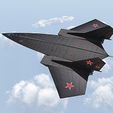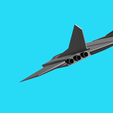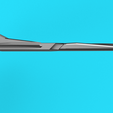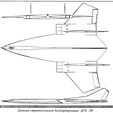But the ‘Darkstar’ didn’t even get off the drawing board. Some reports claim it was merely an experimental academic exercise to gather research for future aviation projects. Others said the advent of the Intercontinental Ballistic Missile (ICBM) rendered the long-range strategic bomber redundant.
But the Leningrad Red Banner Air Force Engineering Academy (LKVVIA Mozhaiski) probably aimed to finally end the contest with the United States to build supersonic, long-range strategic bombers once and for all.
In 1957, it started research with legendary yet unorthodox aeronautical engineer Aleksandr Sergeyevich Moskaliov, following instructions from the Russian General Staff.
The purpose was purely research and academic, meant to “develop tactical and technical properties of aircraft, seaplanes, cruise missiles, and aircraft-aircraft projectile systems” for future projects.
DSB-LK stood for Dalniy Strategicheskiy Bombardirovshchik – Letayushcheye Krylo (DSB-LK), meaning Long Range Strategic Bomber – Flying Wing. This was around the same time Lockheed Skunk Works started research on the SR-71 Blackbird after being asked by the Central Intelligence Agency (CIA) to develop a fast-flying spy plane to replace the U-2.
Indeed, the DSB-LK appeared exponentially ahead in terms of speed, role, versatility, payload, and even design than the Lockheed Martin SR-71 when we look at what the eccentric Moskaliov had envisioned.
Hypersonic Piloted Plane?
YouTube channel Found and Explained and others said that Moskaliov explored combining ramjets and, after burning turbojets which would have pushed the maximum speed beyond Mach 4.
Moskaliov DSB-LK strategic bomber
The Soviets wished to completely dominate US air defenses by launching nuclear or conventional missiles at American aircraft carriers and cities with impunity using their raw speed. (It is to be noted that the name ‘Darkstar’ has been coined by Found and Explained, and none of the information has referred to it as this coinage).
Remember, anything beyond Mach 5 is hypersonic, nearly 5,000 kilometers an hour. The DSB-LK would fly at 35 kilometers (114,000 feet) and a range of 16,000 kilometers, depending upon where it would take off from the vast United Soviet Socialists Republics (USSR). Secret Projects UK, too, claimed the upper limit of the estimated speed was Mach 4.
However, other forums said the six VK-15M turbojet engines (6 numbers), each with a thrust of 10,000 kilograms and 15,800 kilograms on afterburner, could push to a maximum speed of Mach 2.8.
The bomber’s ‘take-off run’ should be a little more than 1,100 meters, a take-off speed of 335 kilometers an hour, and a landing speed that does not exceed 190 kilometers.
The first design milestone in the DSB-LK was the ‘fused wing-body/fuselage’ approach, seen in the Su-57. The tube-like middle body and spine seem almost non-existent and merged with the wing.
The extreme form is a flying wing, like the B-2 Spirit stealth strategic bomber or Russia’s own S-70 Okhotnik (Hunter) drone. The DSB-LK, however, appears more like the former and not a complete flying wing, based on comments on the project on Russian social media.
Design & Armament
Photos available on the internet and forums run by enthusiasts suggest an underbelly concealed/internal weapons bay capable of carrying cruise missiles, unguided drop bombs, air-to-air missiles, or a combination.
Three engines on each side with a swept-back delta wing and two vertical stabilizers (tails) suggest that the plane was not built for maneuverability. One can easily see the strikingly attractive and futuristic design.
The absence of any part that creates ‘drag’ while the entire aircraft looks very sleek with good airflow around it means it was never meant to take tight turns.
Just tearing into a target zone within a matter of time at unstoppable hypersonic speeds, releasing the missiles, and then turning back to the homeland while enemy radars and air defense systems watch helplessly must have been the profile intended. DSB-LK could streak in and sink a US aircraft carrier, fly overhead, or turn around and speed away.
Around 50 meters and 30 meters of wingspan, the DSB-LK was massive. It would be essential to note that sometimes planes are deliberately made aerodynamically unstable for more excellent maneuverability, a case in point being the Dassault Rafale.
The stability is achieved electronically through a Flight Control System (FCS), a digital-fly-by-wire system, and other heavily programmed avionics with possibly millions of lines of software code.
The Russians had another advantage of abundant titanium in their bank of natural resources to construct such a plane. The metal is the only one capable of withstanding the immense pressure and heat generated during hypersonic flights.
Ironically, the United States had to secretly import titanium from the USSR for the SR-71 Blackbird, using a series of shell companies and routing the consignments through Third World nations.
The fuselage was triangular shaped, with each of the two groups of three engines housed in nacelles. It was crewed by three to four seated in two different compartments, with two being pilots and the remaining being navigators or one being a Weapons System Operator (WSO).
It was also designed to carry two-gun turrets, one just behind the cockpit on the spine and the other above the exhausts. Each gun could fire 7 to 9,000 rounds per minute and carry a maximum of 1,200 rounds. For additional protection against enemy interceptors, it could carry 4-5 air-to-air missiles with a range of 10 kilometers.
Lastly, its combat payload was planned between 5 to 15 tons, consisting of a mix of cruise missiles and bombs. It was planned to have a Rubin-1 radar system and an “interference system,” which can mean Electronic Warfare (EW) and jamming systems.

/https://fbi.cults3d.com/uploaders/13614381/illustration-file/98b9aa43-8df3-4433-b2e0-6f236aff546e/main-qimg-e2dce029a422b32529b28da99d18140b-lq.jpg)















